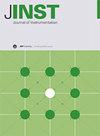A proposal for a fast infrared bursts detector
IF 1.3
4区 工程技术
Q3 INSTRUMENTS & INSTRUMENTATION
引用次数: 0
Abstract
The gravitational wave GW170817 from a binary neutron star merger and the simultaneous electromagnetic detection of the GRB170717A by Fermi Gamma-Ray Space Telescope, opened a new era in the multi-messenger astronomy. Furthermore, the GRBs (Gamma-Ray Bursts) and the mysterious FRBs (Fast Radio Bursts) have sparked interest in the development of new detectors and telescopes dedicated to the time-domain astronomy across the electromagnetic spectrum. Time-domain astronomy aims to acquire fast astronomical bursts in temporal range between a few seconds down to 1 ns. Fast InfraRed Bursts (FIRB's) have been relatively understudied, often due to the lack of appropriate tools for observation and analysis. In this scientific scenario, the present contribution proposes a new detection system for ground-based reflecting telescopes working in the mid-infrared (mid-IR) range to search for astronomical FIRB's. Experience developed in the diagnostics for lepton circular accelerators can be used to design temporal devices for astronomy. Longitudinal diagnostic instruments acquire bunch-by-bunch particle shifts in the direction of flight, that is equivalent to temporal. Transverse device integrates the beam signal in the horizontal and vertical coordinates, as standard telescopes. The proposed instrument aims to work in temporal mode. Feasibility study tests have been carried out at SINBAD, the infrared beam line of DAFNE, the e+e- collider of INFN. SINBAD releases pulsed infrared synchrotron light with 2.7 ns separation. The front-end detector system has been evaluated to detect temporal fast infrared signals with 2–12 μm wavelengths and 1 ns rise times. The present contribute aims to be a step toward a feasibility study report.关于快速红外猝发探测器的建议
双中子星合并产生的引力波 GW170817 和费米伽马射线太空望远镜同时探测到的电磁波 GRB170717A 开启了多信使天文学的新纪元。此外,GRB(伽马射线暴)和神秘的 FRB(快速射电暴)也引发了人们对开发新的探测器和望远镜的兴趣,这些探测器和望远镜专门用于整个电磁频谱的时域天文学。时域天文学旨在获取时间范围在几秒到 1 ns 之间的快速天文爆发。对快速红外脉冲串(FIRB)的研究相对较少,这往往是因为缺乏适当的观测和分析工具。在这一科学背景下,本论文提出了一种新的探测系统,用于中红外(mid-IR)范围内的地基反射望远镜,以搜寻天文中的快速红外暴。在轻子环形加速器诊断方面积累的经验可用于设计天文学的时间装置。纵向诊断仪器获取粒子束在飞行方向上的逐束偏移,这相当于时间诊断。横向设备在水平和垂直坐标上整合光束信号,就像标准望远镜一样。拟议的仪器旨在以时间模式工作。已经在 SINBAD、DAFNE 的红外光束线和 INFN 的 e+e- 对撞机上进行了可行性研究测试。SINBAD 释放的脉冲红外同步加速器光的间隔为 2.7 ns。对前端探测器系统进行了评估,以探测波长为 2-12 μm、上升时间为 1 ns 的时间快速红外信号。本报告旨在向可行性研究报告迈出一步。
本文章由计算机程序翻译,如有差异,请以英文原文为准。
求助全文
约1分钟内获得全文
求助全文
来源期刊

Journal of Instrumentation
工程技术-仪器仪表
CiteScore
2.40
自引率
15.40%
发文量
827
审稿时长
7.5 months
期刊介绍:
Journal of Instrumentation (JINST) covers major areas related to concepts and instrumentation in detector physics, accelerator science and associated experimental methods and techniques, theory, modelling and simulations. The main subject areas include.
-Accelerators: concepts, modelling, simulations and sources-
Instrumentation and hardware for accelerators: particles, synchrotron radiation, neutrons-
Detector physics: concepts, processes, methods, modelling and simulations-
Detectors, apparatus and methods for particle, astroparticle, nuclear, atomic, and molecular physics-
Instrumentation and methods for plasma research-
Methods and apparatus for astronomy and astrophysics-
Detectors, methods and apparatus for biomedical applications, life sciences and material research-
Instrumentation and techniques for medical imaging, diagnostics and therapy-
Instrumentation and techniques for dosimetry, monitoring and radiation damage-
Detectors, instrumentation and methods for non-destructive tests (NDT)-
Detector readout concepts, electronics and data acquisition methods-
Algorithms, software and data reduction methods-
Materials and associated technologies, etc.-
Engineering and technical issues.
JINST also includes a section dedicated to technical reports and instrumentation theses.
 求助内容:
求助内容: 应助结果提醒方式:
应助结果提醒方式:


